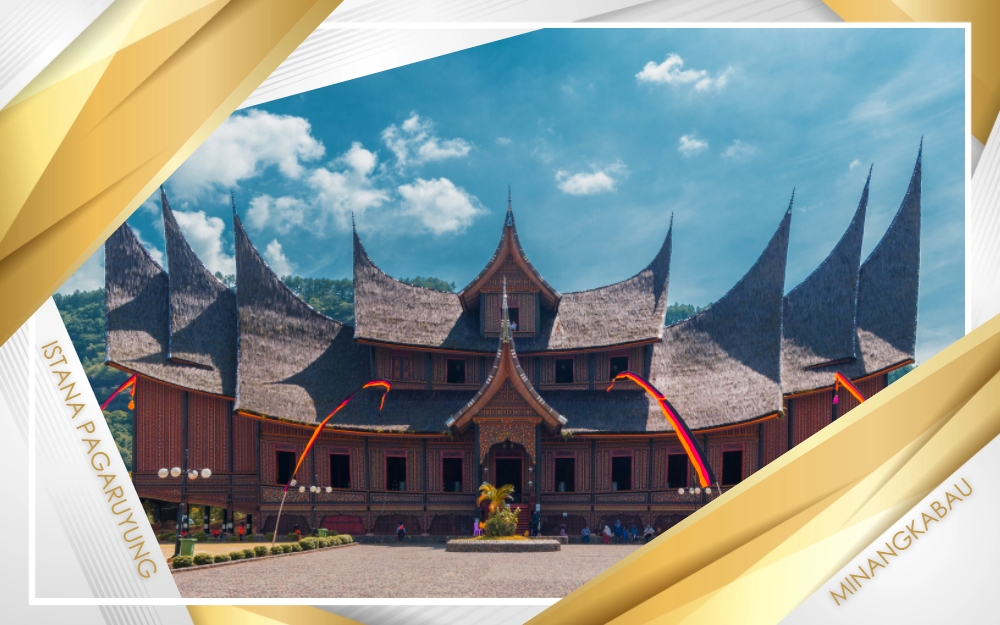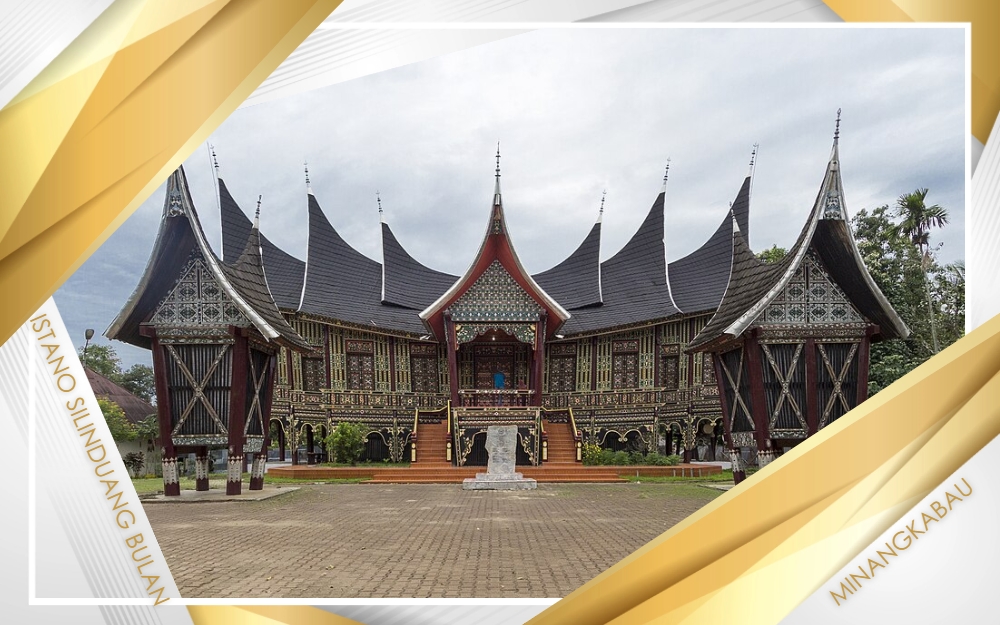Exploring the Marvels of Rumah Gadang architecture

Rumah Gadang, translating to “big house” in Minangkabau, is a traditional architectural style indigenous to the Minangkabau people of West Sumatra, Indonesia. This distinctive form of architecture is renowned for its iconic roof structure, which resembles buffalo horns and symbolizes the buffalo, a sacred animal in Minangkabau culture.
The Rumah Gadang is characterized by its elongated, rectangular shape and steep, curved rooflines that sweep upward at each end, creating a unique horn-like appearance. The roofs are typically made of thatch or wooden shingles, and the entire structure is supported by a complex system of wooden columns and beams. The intricate carvings adorning the exterior of the house often depict cultural and religious motifs, showcasing the rich heritage of the Minangkabau people.
These houses are not only architectural marvels but also serve as cultural symbols and social centres for the community. Traditionally, Rumah Gadang is a communal dwelling where extended families live together, fostering a sense of unity and shared identity. The interior is divided into separate spaces for different family members, reflecting the matrilineal nature of Minangkabau society.
Despite modernization, Rumah Gadang remains a prominent cultural and architectural emblem, with efforts made to preserve and promote its significance. The unique design, rooted in the traditions and beliefs of the Minangkabau people, continues to captivate observers and stands as a testament to the enduring cultural heritage of Indonesia.
Notable Hallmarks of Rumah Gadang Architecture Style
Rumah Gadang architecture is a traditional architectural style that originates from the Minangkabau ethnic group in West Sumatra, Indonesia. It is known for its distinctive roof structure, which resembles buffalo horns. The Rumah Gadang architectural style is primarily associated with traditional Minangkabau houses rather than individual buildings designed by specific architects. It’s a traditional vernacular style that has been passed down through generations within the Minangkabau community. As such, there isn’t a comprehensive list of modern buildings designed in the Rumah Gadang style by specific architects. However, you can find variations and influences of Rumah Gadang in contemporary structures or adaptations in modern buildings in Indonesia and beyond.
While Minangkabau architecture is more commonly associated with residential buildings, some public and religious structures also incorporate this style. Here are a few examples:
Istana Pagaruyung (Pagaruyung Palace): Located in Batusangkar, West Sumatra, this palace is one of the most iconic examples of Minangkabau architecture. It was the royal palace of the former Pagaruyung Kingdom.
Rumah Gadang: The traditional Minangkabau house is called Rumah Gadang, which translates to “big house.” These houses are characterized by their distinctive roof structure with upward-curving ends resembling buffalo horns. Rumah Gadang is commonly found in Minangkabau villages.
Surau Batusangkar: A surau is a traditional Islamic assembly building. The Surau Batusangkar is an example of how Minangkabau architectural elements are incorporated into religious structures.
Istano Silinduang Bulan: Another palace located in Batusangkar, this structure showcases the elegance of Minangkabau architecture and serves as a historical site.
It’s important to note that the Minangkabau people have preserved their architectural heritage, and traditional houses can still be found in many villages in West Sumatra. The unique design of Rumah Gadang and its distinctive roof style has become a symbol of Minangkabau identity.

Istano Baso Pagaruyung
Istana Pagaruyung, located in Batusangkar, West Sumatra, Indonesia, stands as an emblem of the rich cultural heritage of the Minangkabau people. Also known as Pagaruyung Palace, it serves as a testament to the traditional architecture and royal history of the region. The palace, with its distinctive Rumah Gadang style, boasts a series of multi-tiered roofs that gracefully curve upwards at the ends, resembling the majestic horns of buffalo, a sacred animal in Minangkabau culture.
Originally constructed in the 19th century, Istana Pagaruyung served as the royal palace for the Pagaruyung Kingdom. The complex, surrounded by lush landscapes, includes the main palace building, pavilions, and ceremonial spaces. Despite facing destruction by fire in 1804 and 1966, the palace has been meticulously reconstructed, preserving its cultural significance.
Visitors to Istana Pagaruyung are immersed in the intricate woodcarvings, traditional textiles, and historical artefacts that adorn the palace interior. The surrounding grounds offer a serene atmosphere, providing a glimpse into the royal traditions and lifestyle of the Minangkabau people. Istana Pagaruyung stands not only as a physical structure but as a living heritage site, inviting visitors to connect with the vibrant history and architectural brilliance of the Minangkabau culture.

Minangkabau Houses
Rumah Gadang, translated as “big house,” is an architectural gem and cultural icon of the Minangkabau people in West Sumatra, Indonesia. This traditional dwelling reflects the unique identity and communal values of the Minangkabau community. Characterized by its distinctive roof structure, Rumah Gadang features upward-curving ends reminiscent of buffalo horns, symbolizing the strength and unity of the Minangkabau people.
The design of Rumah Gadang is not only aesthetically pleasing but also functional. The spacious interior accommodates the needs of extended families, showcasing a harmonious blend of communal living and individual privacy. The house is constructed using traditional materials such as wood, bamboo, and thatch, reflecting the local environment and sustainable building practices.
Beyond its architectural significance, Rumah Gadang serves as a cultural repository. The intricate wood carvings adorning the house depict ancestral motifs, mythological stories, and symbols that convey the rich oral history of the Minangkabau. These carvings, coupled with the house’s layout, represent the Minangkabau matrilineal kinship system, where property and inheritance pass through the female line.
Rumah Gadang stands as a symbol of Minangkabau identity and resilience, preserving the cultural heritage of this community for generations to come. As visitors step into the expansive verandas and experience the warmth of its wooden interiors, they are transported into the heart of Minangkabau tradition and architectural brilliance.

Surau Batusangkar
Surau Batusangkar, located in Batusangkar, West Sumatra, Indonesia, is a captivating example of traditional Minangkabau architecture with a religious significance. A surau is a communal Islamic assembly building, and Surau Batusangkar beautifully incorporates the distinctive features of Minangkabau design. The surau serves as a place for worship, religious education, and community gatherings, reflecting the integration of Islam into the cultural fabric of the Minangkabau people.
The architecture of Surau Batusangkar showcases the iconic Rumah Gadang roof style, characterized by its gracefully upswept, horn-like ends. This distinctive roof design is not only aesthetically striking but also holds cultural and symbolic importance within the Minangkabau community.
As a religious space, Surau Batusangkar is adorned with intricate wood carvings and traditional motifs that contribute to the spiritual atmosphere. The carvings often depict Islamic calligraphy, floral patterns, and geometric designs, blending the rich artistic heritage of the Minangkabau people with the principles of Islamic art.
Beyond its architectural beauty, Surau Batusangkar plays a crucial role in the preservation of cultural and religious practices. It stands as a living testament to the harmonious integration of the Islamic faith and traditional Minangkabau customs, providing a serene and culturally rich environment for worship and community engagement.

Istano Silinduang Bulan
Istano Silinduang Bulan is a palace located in the Nagari (village) of Pagaruyung, Tanah Datar, West Sumatra. Currently, the palace is undergoing renovation, initiated on March 21, 2010.
Namo Silinduang Bulan is the name bestowed upon the Palace of the King of Pagaruyung when it was relocated from Ulak Tanjuang Bungo to Balai Janggo in the year 1550 by the Grace of His Majesty, the King of the Universe, Sultan Bakilap Alam (Sultan Alif Kalifatullah Johan Berdaulat Fil’Alam I), who is both the King of the World and holds the positions of King of Tradition and King of Worship in Pagaruyung. In that year, the formal implementation of Islamic Sharia law marked the beginning, replacing laws that were previously based on the Tantrayana Buddhist tradition throughout the Pagaruyung kingdom.
The “Istano Silinduang Bulan” is a traditional Minangkabau house with nine rooms and dimensions of 28 x 8 meters. In its compound stand two rangkiang (pavilions) named Si Bayau-bayau and Si Tinjau Lauik. This Rumah Gadang consists of two floors with nine biliak (bedrooms) and two anjuang (living rooms). On the right side stands Anjuang Ameh, and on the left side stands Anjuang Perak. At the rear is a distinctive kitchen. The house is supported by 52 columns, distributed as follows: 8 columns in the front row, spaced evenly; the second row, stretching along the building, has 12 columns spaced with additional support columns in the middle; the third row, also stretching along the building, has 12 columns with a central support column. One of these 12 columns serves as the main central pillar, or it can also be a taller pillar with decorative carvings at the entrance. The row along the edge consists of 12 additional columns supporting the rear and front sections of the house. Additionally, 12 more columns at the back support the rear and front sections. The two anjuang at the front and rear of the house feature royal thrones, namely Rajo Tuo in Anjuang Ameh and Tuan Gadih in Anjuang Perak.
For more exciting news and facts, check out our website New Facts World and follow us on Instagram.



